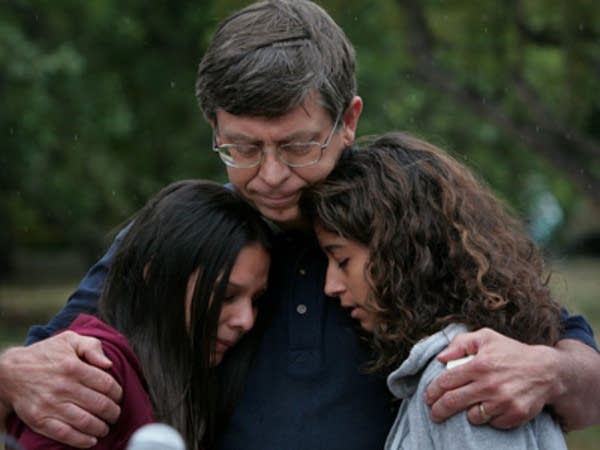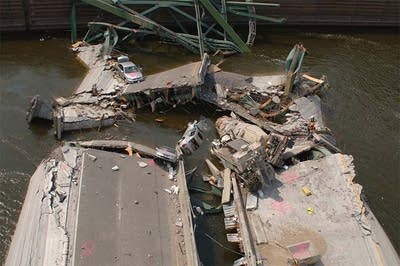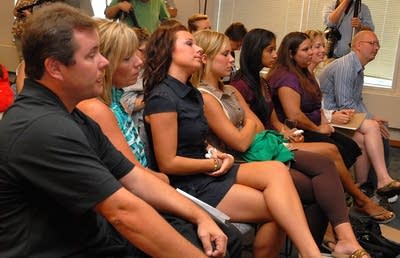Engineering firm to pay $52.4M in bridge collapse

An engineering firm hired to evaluate the Interstate 35W bridge before it collapsed in 2007 has agreed to pay $52.4 million to more than 130 people affected by the tragedy, attorneys announced Monday.
The settlement with URS Corp. was the final lawsuit the bridge victims and their families had pending. They will take away $48.6 million from the URS settlement, bringing the total received from contractors and the state to more than $95 million.
The state has paid the victims $36 million through special legislation. A $10 million settlement was previously reached with PCI Corporation, the construction firm doing work on the bridge when it fell.
Attorney Jim Schwebel, who represented 34 of the plaintiffs, said he's pleased with the settlement. He noted that a three-person panel appointed by the state Supreme Court found that the victims sustained about $100 million in damages.
Create a More Connected Minnesota
MPR News is your trusted resource for the news you need. With your support, MPR News brings accessible, courageous journalism and authentic conversation to everyone - free of paywalls and barriers. Your gift makes a difference.
Schwebel said the panel's estimate and the previous settlement amounts played an important role in negotiations with URS.

"We had in mind what the gap would be that had to be paid, for each of the victims to achieve this fair compensation number," he said. "And we were pleased to be able to accomplish that in this case."
The bridge over the Mississippi River collapsed Aug. 1, 2007, killing 13 people and injuring 145. Attorneys for the victims and their families argued URS knew the bridge was going to fail. URS settled with the state for $5 million in March, but the victims' lawsuit had been moving toward trial.
Last month, the victims' attorneys argued URS should have to pay punitive damages in addition to actual damages for allegedly knowing the bridge would fail. Hennepin County Judge Deborah Hedlund was to rule on that by mid-October.
URS has always argued company engineers didn't know the bridge would collapse because they didn't know about the design flaw federal investigators cited as a major factor in the collapse. The gusset plates on the bridge were only a half-inch thick instead of the full inch they should have been.
An attorney for URS also argued in the most recent hearing that engineers were not due to turn in design calculations on the bridge's integrity to the Minnesota Department of Transportation until five months after the bridge collapsed.

In a statement issued Monday, San Francisco-based URS said that the settlement agreement does not include any admission of liability or fault.
"URS believes it is in the best interest of the company and its shareholders to resolve this matter and avoid the cost and distraction of protracted litigation," the statement read. The $52.4 million will be paid by the company's insurers.
About $2.3 million of the settlement will go to insurance companies that paid workers' compensation and property damage losses, and $1.5 million will go to a memorial garden for the bridge collapse, Schwebel said. He declined to disclose the specific amounts awarded to each victim and said that information will remain confidential.
Several victims of the collapse and their survivors attended the news conference announcing the settlement.
Anne Engebretsen Burke lamented the loss of her mother, Sherry, who was killed in the collapse.
"The pain of our loss will never subside," Burke said. "I just got married about a month ago and I didn't have my mom by my side, and it really hurt."

Garrett Ebling, who was driving on the bridge when it fell, said his injuries linger three years later.
"I get up in the morning and I feel like I'm 70 years old," said Ebling, who is in his 30s. "That wasn't supposed to happen for a long time."
Ebling must carry a card in his wallet to show to security agents at airports because he has so much metal in his head and the rest of his body.
Brandi and Brianna Coulter were college and high school soccer players before the collapse. But their back injuries have prevented them from playing soccer. Their mother Paula sustained a brain injury when their van fell into the river, along with the collapsed bridge.
Attorney Chris Messerly, whose firm represented 103 of the plaintiffs, said more than 100 people at Robins, Kaplan, Miller and Ciresi logged more than 20,000 hours on the case. He said the firm is not taking any of the settlement money.

Messerly said the firm's research indicated that the bridge's design flaw -- the thin gusset plates -- was made worse when roller bearings on the bridge began to freeze up, preventing the bridge from expanding and contracting the way it should.
The National Transportation Safety Board concluded that the design flaw was the main cause of the collapse, and said that before the incident, engineers didn't know gusset plates designed too thin could cause a bridge to fail.
All lawsuits brought by victims have now been settled. But the state and URS still have litigation pending against Jacobs Engineering, the firm that acquired the company that designed the original bridge.
(MPR reporter Madeleine Baran contributed to this report)


